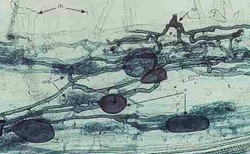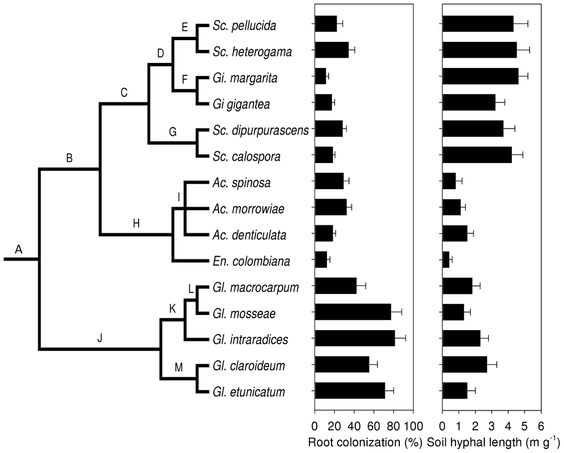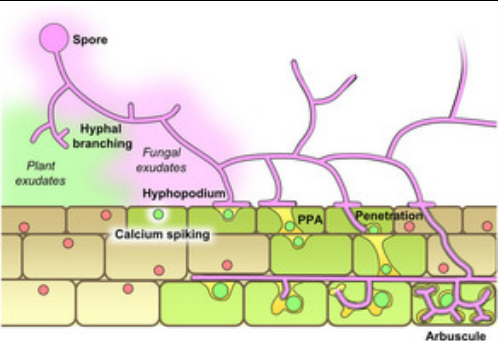Description:
- Is the characteristic species for Gigaspora, a genus known for its exceptionally large spores (2)
- AM fungi are usually generalists: not restricted to a single host species (4)
- Mutualistic symbionts that form arbuscular mycorrhizal (AM) associations intracellularly within the roots of the vast majority of herbaceous plants and tropical trees(1)
- Physically penetrate plant cortical cell walls and form arbuscules along the surfaces of cell membranes (1)
- Receives photosynthetically derived carbon compounds from the plant in exchange for phosphorus and/or nitrogen, with this added resource efficiency, the plant’s tolerance for drought and nutrient-poor soils increases, as does its resistance to pathogens (2)
Habitat(4):
- Global distribution: has been found to occur in every continent except Antarctica
- Has been found to associate with ferns on Atlantic dunes stretching from Quebec to Virginia
- Known to associate with tropical tree hosts in southeastern Brazil
- Tends to associate with trees that make carbon nutrients available in their roots during warm seasons
- Also chooses plant hosts based on the chemical signals that they excrete
- Colonization efficiency of AM fungi depends on soil nutrient level
- Plants that are nutrient-stressed attract more AM fungi
 AM fungi in plant root (8)
AM fungi in plant root (8)
Reproduction:
- Spores are dispersed long distances by wind and water(4)
- Active during warm seasons, sporulates in the winter at the end of its active phase(4)
Interesting Facts(4):
- Plays an important ecological role in the cultivation of agricultural crop species (corn, carrot, grape, soybean)
- Could be harnessed as a sustainable alternative to chemical fertilizer
- AM fungi can promote the extraction of heavy metal pollutants
Summary of Research Article(7):
The research article, Synergism between blue light and root exudate compounds and evidence for a second messenger in the hyphal branching response of Gigaspora gigantea, sought to answer the question: Do blue light and compounds from host root exudates interact to benefit the fungus? A bioassay (previously developed in the Nagahashi and Douds 1995 study) was used to show that hyphal branching of Gigaspora gigantea can be synergistically stimulated with blue light (BL) and semi-purified photo-mimetic compounds (PCs) isolated from host root exudates. The individual treatments of low levels of BL and diluted PCs were ineffective in stimulating hyphal branches but when given together, a synergistic response was observed. The time at which PCs were applied was delayed after exposure to BL to investigate the stability of the second messenger. When the PC was applied 1-3 hours post, a synergistic effect was observed, but 6 hours post, no synergy was observed. It still must be determined whether light and chemical compounds have the same receptor or whether there are 2 separate receptors that initiate the same chain of events via the 2nd messenger.
The research article, Synergism between blue light and root exudate compounds and evidence for a second messenger in the hyphal branching response of Gigaspora gigantea, sought to answer the question: Do blue light and compounds from host root exudates interact to benefit the fungus? A bioassay (previously developed in the Nagahashi and Douds 1995 study) was used to show that hyphal branching of Gigaspora gigantea can be synergistically stimulated with blue light (BL) and semi-purified photo-mimetic compounds (PCs) isolated from host root exudates. The individual treatments of low levels of BL and diluted PCs were ineffective in stimulating hyphal branches but when given together, a synergistic response was observed. The time at which PCs were applied was delayed after exposure to BL to investigate the stability of the second messenger. When the PC was applied 1-3 hours post, a synergistic effect was observed, but 6 hours post, no synergy was observed. It still must be determined whether light and chemical compounds have the same receptor or whether there are 2 separate receptors that initiate the same chain of events via the 2nd messenger.


